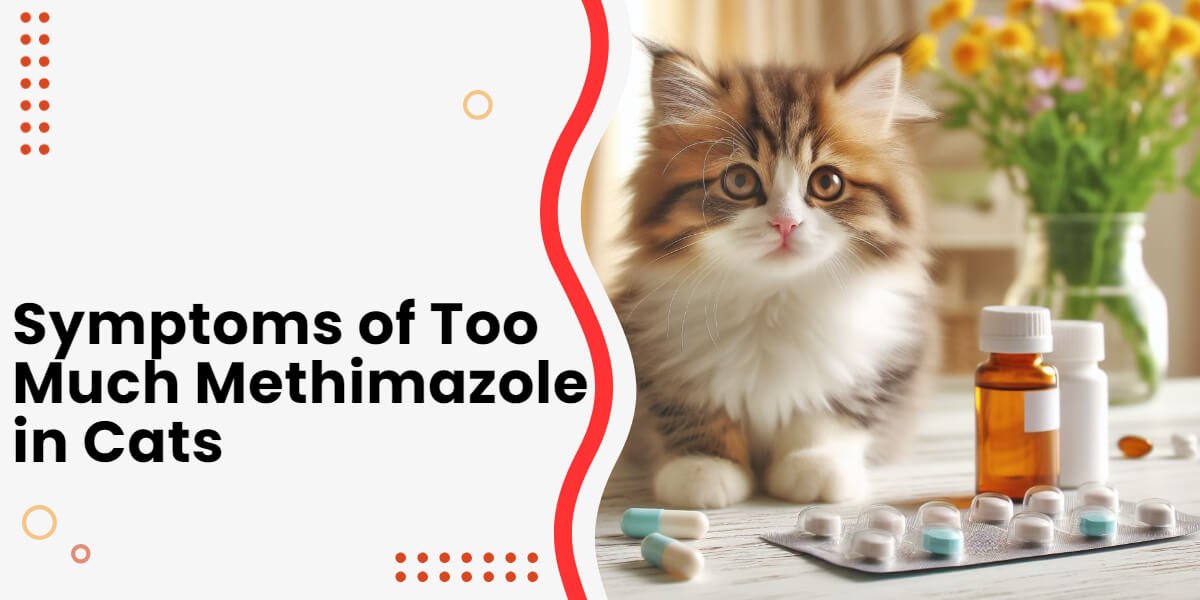Ever wondered how veterinarians tackle feline hyperthyroidism? Enter Methimazole – a human-designed drug that’s become the go-to solution for our furry friends. Widely favored by veterinarians due to its relatively low risk of severe side effects, this medication can work wonders when managed correctly. However, like any remedy, things can take a turn if the dosage isn’t spot-on.
So, let’s dive into the world of Methimazole and uncover the symptoms of too much Methimazole in cats. It’s a crucial read for any cat owner looking out for their feline friend’s well-being.
Table of Contents
The Most Common Symptoms of Too Much Methimazole in Cats
Excessive use of methimazole for cats can lead to common side effects such as diarrhea, nausea, vomiting, blood abnormalities, changes in haircoat and skin, alterations in appetite, and overall weakness. In felines, additional potential side effects may include lethargy, increased thirst, and alterations in litter box habits.
side effects of methimazole in cats
Methimazole is the active ingredient in Felimazole, a pet-specific antithyroid drug that blocks and slows down the production of thyroid hormones. It’s typically administered orally every 12 or so hours, depending on how the cat responds to the treatment.
This medication can be given to stabilize a cat’s status before radioactive iodine therapy or surgery, or given as a life-long medication to treat hyperthyroidism without needing to go through the aforementioned treatments.
Felimazole Coated Tablets is the only FDA-approved hyperthyroidism drug treatment for felines. Compared to human methimazole products, Felimazole is proven to be safer and more effective when used exactly as prescribed by the vet.
If administered without following the recommended dosage, the following may occur:
Diarrhea or Loose Stool

One of the biggest indications of too much methimazole in cats is moderate to severe diarrhea.
Keep in mind that diarrhea is also among the common clinical signs of hyperthyroidism, especially during the first stages of the disease. Thus, it’s often difficult to identify if the gastrointestinal issue is caused by the condition itself or the medication prescribed.
If your cat is experiencing diarrhea for more than three to four days, it’s likely caused by too much methimazole. Visit your veterinarian so he or she may either adjust the dosage or change your cat’s treatment method.
Gastrointestinal Upset
Another common side effect of overmedication is loss of appetite, nausea, and vomiting.
According to Wedgewood Veterinary Pharmacy, the largest animal-devoted pharmacy in the US, up to 20% of cats experience the aforementioned side effects.
Most cats stop vomiting and begin to feel relatively better after a couple of days of regular administration, but others require their dosage reduced.
If your cat still doesn’t feel well after a week, your veterinarian may prescribe a transdermal methimazole gel. Instead of taking the medication by mouth, a transdermal gel is applied on the skin, where it’s then absorbed into the cat’s bloodstream.
Compared to oral methimazole treatment, transdermal treatment may take longer before the full effect is seen. Regardless, it has fewer side effects due to its slow infusion rate.
Overgrooming
Cats are generally clean animals and would spend 30 to 50% of their waking hours grooming themselves. However, excessive scratching, biting, or licking is another indication of methimazole overdose.
Reaction to methimazole treatment differs from cat to cat. Some cats become restless and would obsessively groom themselves to feel a bit of relief, especially on the head, neck, and face. Usually, these symptoms stop after a week of treatment.
Recommended: What happens if my cat licks Revolution Plus?
Others, however, may self-mutilate or injure themselves through excessive scratching. When such a situation occurs, methimazole administration might have to be discontinued and other forms of treatment explored.
When excessive scratching is accompanied by skin lesions, rash, bleeding disorders, and cold limbs, stop the treatment immediately. These symptoms are caused by a methimazole allergy.
Methimazole allergy is extremely serious and might even be fatal, leading to seizures, shock, coma, and even death.
Blood Abnormalities
Approximately 50% of cats are found to have developed blood abnormalities after six months of continuous methimazole treatment.
The most common of these abnormalities include elevated ALT levels (alanine transferase, a liver value), elevated BUN levels (blood urea nitrogen, a kidney value), and positive ANA (antinuclear antibody, misdirected attack on the body’s tissue).
Cats that experience these blood abnormalities require dose reduction and observation for several weeks. If the abnormalities persist, medication must be stopped immediately.
Commonly observed symptoms of blood abnormalities include:
- Fever
- Enlarged lymph nodes
- Abnormal skin color
- Bloody urine/stool
- Dehydration
- Weakness and lethargy
- Loss of appetite/anorexia
According to Wedgewood Pharmacy, 15% of cats suffer from temporary changes in red and white cell count (low level of neutrophils, low platelets, etc).
Usually, changes occur within two months of the treatment. If the cat’s blood count drops to dangerously low or high levels due to methimazole, medication should either be decreased or stopped.
When left untreated, the cat may develop life-threatening changes in her bone marrow, liver, and blood.
Haircoat and Skin Abnormalities

The condition of your cat’s skin and coat are good indicators of her health status. The VCA Animal Hospital states that a cat’s coat should be smooth and shiny as opposed to coarse or brittle. Healthy skin should be supple and clear, not bumpy, flaky, or greasy.
If you’ve noticed changes in your cat’s hair coat while grooming her, you might want to visit your veterinarian at the earliest possible date. Apart from being a symptom of methimazole overdose, it could also indicate an underlying health issue that’s unrelated to hypothyroidism.
Common haircoat and skin abnormalities include:
- Excessive hair loss and dander
- Uncontrollable tangles
- Greasiness
- Thinning or balding patches
- Lumps under the skin
- Flaky and/or dry skin
Vocalization Abnormalities
If your cat excessively vocalizes during the first few weeks of methimazole treatment, she might be trying to tell you that she’s in severe stress, discomfort, or pain. It might be associated with her chronic disease or it might have been brought about too much methimazole in her system.
Cats who yelp or yowl when touched might also be an indication of methimazole overdose.
For the first few days, try to eliminate any stress factors that might trigger your cat. Don’t leave her in a noisy environment and keep her litter box and food area clean. Make sure she has enough food and water to eat and drink every day.
If her meowing returns back to normal after the first week of methimazole treatment, continue with the prescribed dose. But if your cat’s meows turn urgent and loud, it’s best to visit a vet to have her checked out as soon as possible.
Again, if the veterinarian found that her distress is caused by the methimazole, your vet may either lower the dose, change it from oral to transdermal, or offer other treatment solutions.
Related: Alternatives to Atopica for cats
Weakness and Agitation
If your cat seems a bit more aggressive or agitated than usual, or if she doesn’t play or act like she normally does, this may be a sign of overmedication.
Rarely, cats develop myasthenia gravis due to methimazole overdose, a neuromuscular disease that weakens the skeletal muscles. They may also begin to experience ataxia, a symptom of an underlying disorder that affects a cat’s motion and balance.
Symptoms of weakness in cats include:
- Clumsy movements
- Wobbly gait
- Swaying
- Leaning
- Abnormal eye movements
- Head tilting
- Abnormally high steps
- Vomiting
- Tremors
Ataxia comes in three primary forms: cerebellar, vestibular, and sensory. Ataxia caused by overmedication is called vestibular ataxia.
Severe vestibular disease can be fatal, but only if it isn’t caught early. If your cat is showing any of the symptoms above, immediate veterinary care is needed.
Change in Appetite
Weight gain is a common side effect of methimazole treatment in cats. As long as your cat doesn’t gain more than 5% of her weight within the first six months of treatment, and doesn’t appear to show any other worrying symptoms, it shouldn’t be much of a concern.
A cat with hypothyroidism often has an increased appetite, which therefore causes weight gain. However, if your cat is abnormally hungry and would constantly beg for food, you might want to visit a vet. A cat should only eat up to two times a day or approximately 1/3 to 1/2 cup of food each day.
With that being said, there are instances where cats experience the complete opposite. Despite their increased appetite, they may still undergo significant weight loss. Like most of the symptoms on this list, this might be caused by the cat’s hyperthyroidism or a sign of medication overdose.
On a less serious note, it’s possible that your cat’s change in appetite is caused by the change in food, location, or food bowl.
Cats with hyperthyroidism should be fed an iodine-restricted prescription diet, with little to no fruits, grains, or vegetables. If your cat is used to a certain type of food, she may refuse to eat for a few days. Eventually, she’ll give up and eat what’s in front of her.
Cats who are being treated with an iodine-restricted diet shouldn’t be fed anything other than the prescribed food. This includes treats, human food, and anything caught through hunting or scavenging.
Frequently Asked Questions (IMPORTANT)
What is the optimum Methimazole dosage for cats?
As a start, it’s proven safe to start with a dosage of 2.5 mg every 12 hours.
Can I give my cat methimazole once a day?
Yes, if your cat suffers from hyperthyroidism, you can use methimazole safely to be given up to two times per day (every 12 hours). However, if you forget to give your cat its methimazole doze and the next one is coming up close, I’d advise you to skip this dose and wait for the next one.
Can methimazole kill my cat?
If you’re giving your cat the correct dosage and following up with your vet about your cat’s situation, your feline friend will be fine. Worst case scenario would be that methimazole won’t be the solution for your cat’s case.
can a cat overdose on methimazole
Yes, a cat can overdose on methimazole. Overdosing may result in symptoms such as lethargy, vomiting, or difficulty breathing. Immediate veterinary attention is crucial if overdose is suspected. Always administer methimazole according to the veterinarian’s prescribed dosage to prevent adverse effects. If concerned about dosage or potential overdose, consult your vet promptly.
Final Thoughts
In conclusion, being mindful of the potential side effects of too much Methimazole in cats is crucial for their well-being. Keep an eye out for symptoms such as diarrhea, blood abnormalities, and changes in appetite. If you notice any adverse reactions, don’t hesitate – whisk your feline friend to the vet promptly.
Remember, long-term exposure to excessive Methimazole can be perilous, even fatal. Following your vet’s recommended dosage is your best bet to safeguard your cat’s health. Stay vigilant, stay informed, and ensure your cat’s journey to health is nothing short of perfection.

I’ve been living with cats since 2008 and I can confidently say I have more feline friends than humans lol. I currently live with 5 cats in different life stages; two of them are less than one year old, one is 2-ish years old and the oldest two are 9-ish years old. I’ve developed a strong bond with cats over the years and I’m eager to share my experience through this blog. You can learn more about my cats here.

